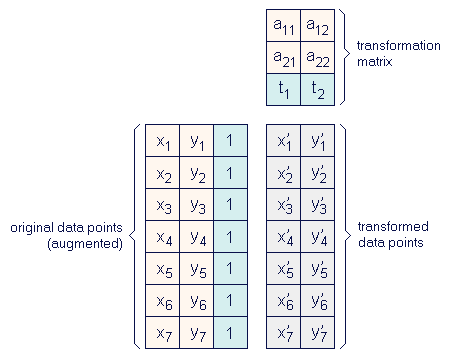| Fundamentals of Statistics contains material of various lectures and courses of H. Lohninger on statistics, data analysis and chemometrics......click here for more. |

|

Home  Math Background Math Background  Matrices Matrices  Multiplication Multiplication  Geometrical Meaning of Matrix Multiplication Geometrical Meaning of Matrix Multiplication |
|||||||||||||
| See also: matrix multiplication | |||||||||||||
Geometrical Meaning of Matrix MultiplicationMatrix multiplication is a versatile tool for many aspects of scientific or technical methods. One particular application of matrix multiplication is the transformation of data in n-dimensional space. Data can be scaled, shifted, rotated, or distorted by a simple matrix multiplication. In order to achieve all these operations by a single transformation matrix, the original data has to be augmented by an additional constant value (preferably 1). In order to see the effects of matrix multiplication, you can start the following interactive example . Example: transformation of two-dimensional points. Suppose you have seven data points in two dimensions (x, and y). These seven data points have to be submitted to various transformation operations. Therefore we first augment the data matrix, denoted by [xi,yi], with a constant value, resulting in the point vectors [xi,yi,1].  For performing the various transformations, we simply have to adjust
the transformation matrix.
|
|||||||||||||
Home  Math Background Math Background  Matrices Matrices  Multiplication Multiplication  Geometrical Meaning of Matrix Multiplication Geometrical Meaning of Matrix Multiplication |
|||||||||||||





